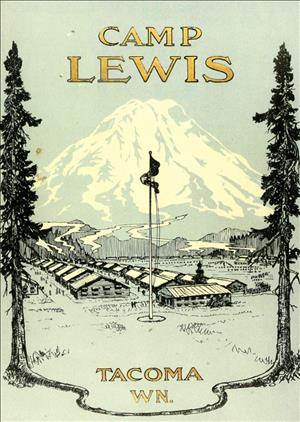On January 6, 1917, Pierce County residents vote to bond themselves for $2 million dollars to purchase 70,000 acres of land on the Nisqually Plains at American Lake. The land will then be turned over to the federal government free of charge for development into a military post. The facility will first be called Camp Lewis (and later Fort Lewis, which will merge with McChord Air Force Base to become Joint Base Lewis-McChord). Camp Lewis was named to honor Captain Meriweather Lewis (1774-1809), co-leader of the Corps of Volunteers for Northwestern Discovery (Lewis and Clark) expedition.
Patriotism and Pragmatism
In 1916, as many Americans began to consider inevitable the United States' entry into World War I. In the wake of the tragedy, civic leaders organized as the Pierce County Military Base Committee worked to achieve a long-standing dream of Pierce County boosters -- securing a major permanent U.S. military installation on the Nisqually Plains at American Lake south of Tacoma, which had been used for maneuvers and temporary encampments since 1890, and touted as a base site nearly that long.
Taking advantage of legislation approved by Congress on August 29, 1916, that allowed the Secretary of War to accept donated lands for military use, three members of the Military Base Committee -- Tacoma banker and committee chairman Stephen Appleby (1869-1950), Tacoma News Tribune publisher Frank S. Baker (1880-1960), and realtor Jesse O. Thomas (1877-1967) -- met that October in Washington, D.C., with Secretary of War Newton D. Baker (1871-1937) to work out a deal. They reached an agreement that if Pierce County donated the land, the federal government would establish and maintain a permanent army post there. Besides their patriotic impulses, Baker, Appleby, and Thomas recognized that this arrangement would be an enormous economic and strategic asset for Pierce County. President Woodrow Wilson (1856-1924) endorsed the plan, and in December Secretary Baker formally accepted the Pierce County proposal. But the county needed to acquire the land before it could donate it to the army, and that required voter approval of a bond issue.
Voters Approve
Frank Baker used the Tacoma News Tribune to whip up public support for the land purchase. The ballots for the bond measure read, "Shall Pierce County incur an indebtedness not exceeding $2,000,000 for the purpose of acquiring approximately 70,000 acres of land in Pierce County and conveying the same to the United States, said land to be used by the Government for mobilization, training, and supply station; said indebtedness to be evidenced by negotiable bonds of Pierce County, payable in not more than twenty years, with interest not exceeding 5 per centum per annum, payable annually?" (Bonney, 607). The vote in the special election held on January 6, 1917, was overwhelmingly in favor of the bonds.
The United States declared war on Germany, entering World War I, on April 6, 1917. Three days later Companies E and F of the United States Engineers began surveying the donated land at American Lake, deciding where to locate various buildings. The need to begin construction was urgent and not all the necessary land had yet been secured. Arrangements were made allowing the federal government to use the land anyway. (Pierce County would not officially complete the transfer of title to the federal government until November 1919.)
Not all of those whose lands were taken for the base had any say in the vote. More than 3,350 of the 70,000 acres whose transfer voters approved were Nisqually Indian allotments. At that time the Nisqually Reservation was located on both the Thurston County and Pierce County sides of the Nisqually River, and all of the reservation lands in Pierce County, two thirds of the total reservation, were included within the planned base. However while they lived within the boundaries of Pierce County, the Nisqually tribal members could not vote because, like all American Indians living on reservations at the time, they were not United States citizens.
Initially Camp Lewis construction and training exercises took place some distance from the Nisqually lands, but by October 1917 troop maneuvers were damaging Nisqually farms, and that December the army announced that it needed all the reservation land on the Pierce County side of the river. Court challenges to the county's ability to condemn reservation lands were rejected, and in April 1918 the Nisqually landholders were paid a small portion of their lands' value and hurriedly removed. (Congress provided some additional compensation in 1921, three years before it finally granted U.S. citizenship to all Native Americans.)
A Perfect Storm
In May 1917 Captain David S. Storm arrived with a staff to oversee construction of the new camp. In June 1917 Tacoma's Hurley-Mason Company won the construction contract for the new facility. Hurley-Mason then purchased 25 million feet of lumber from local mills, paying $16.50 per thousand feet.
Captain Storm's construction crew was a civilian army: Some 10,000 local carpenters, plumbers, electricians, plasterers, and other laborers swarmed over the site. Construction began on July 5, 1917. In only three months 1,757 plumbed, heated buildings complete with electric lighting were ready for occupation.
The construction crew collected $4,000 from among themselves to build a decorative main gate for the compound. The gate was made of fieldstone and rough-hewn logs and designed to resemble two connected blockhouses. This gate was moved out of the path of freeway construction and rebuilt during the 1950s. As of 2015 the rebuilt gate still stood on the grounds of Joint Base Lewis-McChord.
Preparing for "Over There"
The first troops arrived at Camp Lewis in September 1917. Pierce County sent its first young soldiers to the camp on September 8, 1917. In November French Army officers arrived to help train American soldiers for the actual conditions they would face overseas. By late December some 40,000 troops were stationed at Camp Lewis, preparing to ship out for active duty on the battlefields of France.
On September 30, 1927, Camp Lewis became a permanent Army post and was re-designated as Fort Lewis.

